Tweaks for Geeks IV – Winter 2023 by Greg Simmons
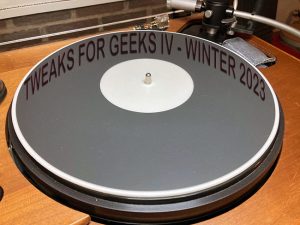
 More Good Stuff You Might Need
More Good Stuff You Might Need
It’s cold here in Pittsburgh (Hey, yinz guys!). I caught my fat orange cat lolling on my power amplifier last week. But being trapped in the house isn’t all bad. It leaves plenty of time to write about some inexpensive stuff that could dramatically improve the quality of your life – or at least make it sound better. Welcome to the fourth installment of Tweaks for Geeks, highlighting useful hi-fi accessories that do not require groveling before a loan officer.
Today we’re starting with…
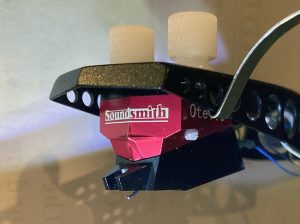
SoundSmith – Cartridge Rebuilding Service
Of all the things you can buy used on USAudiomart or Audiogon, a phono cartridge is undoubtedly the riskiest. It’s the only mechanical item in most hi-fi systems that experiences true wear-and-tear friction as that teeny tiny little diamond rides the grooves at what is said to be the equivalent of 300 lbs. per square inch. In private sale descriptions, the term “Very lightly used” is subjective and can mean anything from a dealer demo with just a few plays to a ten-year-old beater that the seller believes meets the definition because the ragged remains of a diamond chip are still dangling from the end of the cantilever. Buyer beware.
In my recent modification of an old Technics 1200 turntable with a newly rebuilt SME 3009 arm, I took that risk – largely to keep within the project budget – and purchased a “very lightly used” SoundSmith Otello moving iron cartridge. It made good music, and I said so in the article, but that was definitely not the end of the story. As I was completing my edits, I ham-handedly managed to pop the stylus right off the end of the cantilever necessitating a repair, a sequence which, though it started as an unfortunate accident, ultimately drove a remarkably positive outcome.
SoundSmith offers what is undoubtedly the best rebuild program in the industry: a complete rebuild and stylus replacement of any of their own cartridges for a small fraction of the original purchase price. Bust up your $4,000 Paua? SoundSmith will rebuild the cartridge for $550. Compare that to most other high-end cartridge manufacturers that routinely charge 50% of the original purchase price, and -if the sound is your cup of tea – the SoundSmith option is a screaming bargain. The rebuild price of each of their cartridges is listed on their website.
In the case of my poor Otello – which is SoundSmith’s entry-level Moving Iron cartridge – the rebuild cost was a mere $100 plus shipping. The returned cartridge has a nice, clean, shiny new cantilever and stylus, and it came home with a new set of elongated half-moon spacers that further isolate the cartridge from the headshell. Communication was good, expectations were met, and the returned cartridge sounded audibly better than before I broke it.
So, getting back to the phrase “very lightly used.” Listening to this newly factory-rebuilt Otello, it is clear that the used cartridge I bought had more wear on it than the seller either realized or let on (I’ll give him the benefit of the doubt). It sounded good, but I’m really pleased with how much better it sounds following the factory service—damned good. I won’t go into all of its improved qualities at length here, as I’ll be doing a stand-alone review of the cartridge in the near future. Still, the SoundSmith Otello is a far better cartridge than I thought it was when I wrote it up with the Tech-12 modification article. It deserves a deeper dive.
And here’s the point. Purchasing a SoundSmith cartridge – any SoundSmith cartridge – gives the buyer the reassurance that if you ever break it or the cartridge wears out, SoundSmith will rebuild it at what I could only describe as a nominal cost. Instead of buying a whole new pickup or spending half-again as much to get one repaired, SoundSmith essentially allows its owners to get a new cartridge as often as necessary for pennies on the dollar. With the price of cartridges (and everything else) spiraling ever higher, that is a serious value-added proposition from a respected, quality manufacturer, and very much worth considering with the purchase of your next cartridge.
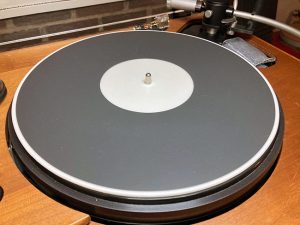

Herbie’s Audio Lab Way Excellent II Platter Mat
Sota owners will think this is nuts, but the last time I had my series III Sota Star-Sapphire back at the factory, I had them remove the vacuum system. Heretic!!! After all, the vacuum is the hallmark of Sota turntables, but the audible difference – if any – is negligible, at least in my system, and simplicity is good. Besides, if I ultimately conclude that I’m missing something, I can always have them re-install it. As of this writing, I haven’t felt the need.
The Sapphire has just a naked aluminum platter surface with the vacuum removed. Many non-vacuum Sota owners place their records directly onto that platter with no mat. They seem happy with that setup (Despite the strong association with the brand, the vacuum is an option, not standard, and there are plenty of non-vacuum tables out there). But in my system, placing the record directly on the platter left the sound mechanical, hard, and brittle, at least to my ears. Not to my liking at all. A platter mat purges the worst of those unfortunate characteristics.
But which mat? There are so many. Over the past two years, I’ve tried a variety, including cork, rubber, felt, and a Funk-Firm Achromat. Each of them had good qualities, but none of them was perfect. There were tradeoffs in background noise, detail, and soundstage. The cork – a 3mm rubberized Thorens version – was the best of the lot, and I used it for years.
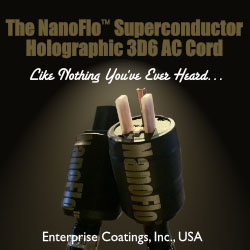 This past December, looking for an inexpensive tweak to play around with over the holidays, I ordered a Herbie’s Way Excellent platter mat, 290mm in diameter and 3.4mm thick. I was particularly interested in this mat because the online peanut galleries suggested that many users had enjoyed significantly reduced background noise, a particular pet peeve of mine with a moving coil that picks up everything.
This past December, looking for an inexpensive tweak to play around with over the holidays, I ordered a Herbie’s Way Excellent platter mat, 290mm in diameter and 3.4mm thick. I was particularly interested in this mat because the online peanut galleries suggested that many users had enjoyed significantly reduced background noise, a particular pet peeve of mine with a moving coil that picks up everything.
The Way Excellent-II mat is a two-layer affair. The white bottom that makes contact with the platter is “finely textured open-cell silicone foam” said to be chosen for its anti-resonance properties. At the same time, the top layer is a black (actually dark grey) unspecified soft elastomer donut—the hole in the middle leaves room for the label, encouraging good contact with the record surface. The two-tone color scheme also looks cool on the platter—the price: is $74.50.
I have to admit, on my turntable, the Herbie’s Way Excellent-II mat does live up to its reputation. My Lyra Delos, a very quiet pickup with well-maintained records, works best with some damping under the record (which is not the same as the vacuum interface). With the Herbie’s, background noise was indeed audibly reduced, even on older – ‘ahem’ – well-loved records, which was a welcome enhancement. More importantly, the mat delivered a little more of the supple, natural texture that I expect from great recordings. Male vocals have really good weight and dimensionality, bass is nice and tight, and the Lyra’s liquid resolution is unmolested. Most importantly, I have not noted any tradeoff in treble extension, which can sometimes happen when a record is over-damped.
And so, all of my mats now seem to be in their correct places. The Achromat is riding my Tech-12, the cork mat – which had been sharing duty – is now permanently spinning on my ancient Rek-o-Kut T12h, and the Herbie’s Way Excellent-II is ensconced on my Sota where I can unreservedly state that it’s the best mat I’ve ever used on this turntable. It’s a quality product, it’s reasonably priced, and it does a great job. It’s definitely worth checking out.
One final note about Herbie’s Audio Lab.
In the process of writing this article, I visited Herbie’s website and discovered that they did not have a single mat of any type in stock. I contacted the company and received an email from Robert Herbelin, who stated that they expect to have mats back in stock by mid-April 2023, so check their website for availability.
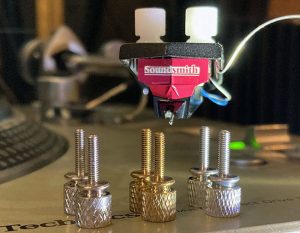
SoundSmith – EZ Mount Cartridge Screws
 Yes, it’s a SoundSmith twofer. Next up is among the simplest, cheapest, and seriously useful tweaks I’ve ever encountered, and one that I’ve owned for years but somehow managed to overlook in previous Tweaks columns: The SoundSmith EZ Mount cartridge screws.
Yes, it’s a SoundSmith twofer. Next up is among the simplest, cheapest, and seriously useful tweaks I’ve ever encountered, and one that I’ve owned for years but somehow managed to overlook in previous Tweaks columns: The SoundSmith EZ Mount cartridge screws.
One of the welcome improvements in cartridges over the past twenty years has been the move by most manufacturers to threaded mounting holes, largely eliminating the need to mess with fiddly little nuts on the underside of the cartridge. I always mounted my Audio-Technica cartridges with the nuts on top of the headshell because it was just easier to work with them that Way. It looked goofy, but with a removable headshell, it was far easier than manipulating a 4mm nut upside-down under a cartridge right next to a hair-thin cantilever. Good riddance to unthreaded mounting holes, and don’t let the door hit you in the backside.
SoundSmith’s contribution to this welcome ergonomic improvement takes the convenience a step further: Instead of tiny screws that require a screwdriver to tighten, Mr. Ledermann and Co. offer screws with textured heads large enough to grip with your fingers. They are easier to use than the tiny slotted ones and are an ice-cold bargain. For a mere $39.99, you get four pairs of screws in different materials with different weights: nylon (1.04g pair), aluminum (2.06g pair), stainless steel (6.3g pair), and brass (6.14g pair). The variety of materials and weights allows the user to add mass or damping to any tonearm/cartridge combination if that’s useful for you. The nylon ones weigh about the same as a pair of the metal screws of the sort that come with most cartridges, and although there’s no real alignment to be done at the headshell on an SME arm, I’m using them to secure my Otello simply because they’re so easy to use. I’ve also used them to secure my Lyra cartridge on both Jelco and Audio Creative arms with good results.
In practice, these finger screws offer some real advantages, especially for cartridge alignment. To make an adjustment, simply loosen the screw with your fingers, shift it, and re-tighten it. The screw itself provides enough purchase to move the cartridge in the headshell without having to actually touch the cartridge itself, reducing the chance of accidentally whacking the cantilever or otherwise damaging the pickup. These EZ Mount screws are an easy tweak, and seriously, how many other useful doodads can you get in hi-fi these days for only forty bucks? Highly recommended.

Headlamps
 This is a shorty, and mostly I just wanted to add a deranged self-portrait. By now – unless you live under a rock – everyone has seen those LED lights that have an elastic band to keep them firmly attached to your head…you know…a headlamp. I’m turning fifty-four this month, well past the point where I care if my daughter thinks I look like a dork. For hi-fi – especially for setting up cartridges or climbing around behind an equipment rack playing with cables – there is almost nothing more useful than one of these headlamps. Most of them throw a LOT of light; many have adjustable positions and variable light intensity. Mine is an inexpensive Energizer, but dozens are available, battery-powered or rechargeable. Most cost between $15 and $30, the rechargeable ones a little more. It’s absolutely indispensable. If you don’t already have one, whichever one you choose, you’ll wonder how you ever got along without it.
This is a shorty, and mostly I just wanted to add a deranged self-portrait. By now – unless you live under a rock – everyone has seen those LED lights that have an elastic band to keep them firmly attached to your head…you know…a headlamp. I’m turning fifty-four this month, well past the point where I care if my daughter thinks I look like a dork. For hi-fi – especially for setting up cartridges or climbing around behind an equipment rack playing with cables – there is almost nothing more useful than one of these headlamps. Most of them throw a LOT of light; many have adjustable positions and variable light intensity. Mine is an inexpensive Energizer, but dozens are available, battery-powered or rechargeable. Most cost between $15 and $30, the rechargeable ones a little more. It’s absolutely indispensable. If you don’t already have one, whichever one you choose, you’ll wonder how you ever got along without it.
Oh yeah…if you want to go full-on Larry the Cable Guy, someone makes a baseball hat with the LEDs built into the brim. If that’s your thing, go for it. We won’t judge.
Looking for Good Stuff
These Tweaks for Geeks columns are a lot of fun to write. In some ways, they’re easier than a full equipment reviews where one must spend a significant amount of time describing sound, the aural equivalent of describing yellow to a person who’s been blind since birth.
If you’ve got a useful, relatively inexpensive hoojamaflip or thingamajig – no more than a few hundred bucks, and certainly less – and you’d like to have it included in one of these columns, by all means, email me through the website. I’m happy to consider it. Regards.


![]()
greg simmon
Stereo Times Masthead
Publisher/Founder
Clement Perry
Editor
Dave Thomas
Senior Editors
Frank Alles, Mike Girardi, Russell Lichter, Terry London, Moreno Mitchell, Paul Szabady, Bill Wells, Mike Wright, and Stephen Yan,
Current Contributors
David Abramson, Tim Barrall, Dave Allison, Ron Cook, Lewis Dardick, John Hoffman, Dan Secula, Don Shaulis, Greg Simmons, Eric Teh, Greg Voth, Richard Willie, Ed Van Winkle, Rob Dockery, Richard Doran, and Daveed Turek
Site Management Clement Perry
Ad Designer: Martin Perry


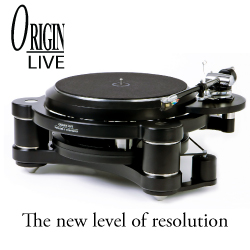
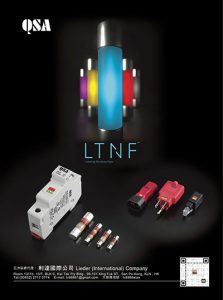

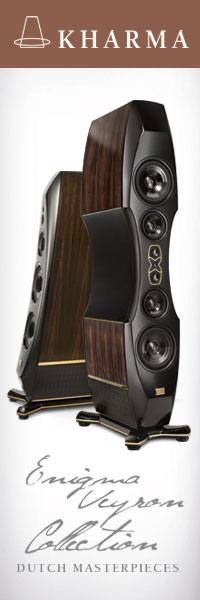


Be the first to comment on: Tweaks for Geeks IV – Winter 2023 by Greg Simmons